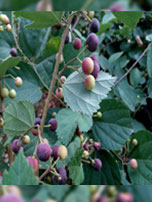Parushaka

Botanical name : Grewia asiatica auct. non L.
Family : Tiliaceae
Introduction :
Latin name: Grewia = after the name of a scientist, Grew Nehemiah; asiatica = of Asia
In south India Phoenix pusilla using as parushaka, In North Grewia asiatica is using.
Names in different Indian languages :
Hindi : Parushaka
Sanskrit : Parushaka
Telugu : Palisa,Thadachi
Unani : Phaalsaa
Synonyms :
Parushaka, Parusha
Grewia subinaequalis DC
Varieties & adulterants – (CV – controversy, AD – adulterants) :
Varieties: There are two varieties – 1) Amlavarga – Falasasharbati, raw is sour and ripe is sweet and juicy. 2) Madhurvarga – Falasashakari – raw is sweet-sour, ripe is sweet and less juicy.
Phoenix pusilla
Morphology :
A tree 8-9 mtrs. high, with grey bark.
Leaves – borders are dentate.
Flowers- small, yellow.
Fruits – round, large, pea shaped, green when raw and pungent, brown when unripe. On ripening, they become violet and swee
Distribution & Habitat :
North India
Chemical constituents :
taraxasterol, betasitosterol, erythrodiol; lupeol, betulin, lupenone, friedelin,,alpha-amyrin.
Properties :
Guna: laghu, snigdha;
Rasa: madhur, amla, kashaya;
Vipaka: madhur (ripe fruit), amla (raw fruit);
Virya: sheeta;
raw fruit – pittavardhak.
Karma :
Antirheumatic, carminative, digestive, astingent,cooling, diuretic, antimicrobial, anthelmintic, antiviral, antipyretic, anti-inflammatory, antifertility, hypoglycaemic
Indication :
fever, skin disease, cough, piles, leucorrhoea,vomiting, dysentery, gout, burning sensation, dyspepsia, cephalgia, worm infection
Part used :
Whole plant
Dosage :
Leaf juice 10-15 ml
Powder 2-4 g
Decoction 50-100 ml
External uses :
Paste of leaves and buds is applied on abscess. Paste of bark is used in osteoarthritis, while that of root is used for inducing abortion (applied on umbilicus, hypogastric region and external genitalia). Fruit infusion is used for gargle in oral conditions.
Internal uses :
Used in anorexia, loss of appetite, diarrhoea, dysentery (raw fruit) whereas ripe fruit
It is given in thirst and as an adjuvant to emetic drugs, also useful in heart diseases and bleeding disorders. Bark decoction is useful in rheumatoid arthritis, asthma. haematuria. burning micturation, diabetes, excessive thirst, vomiting, pyrexia. tuberculosis and debility.